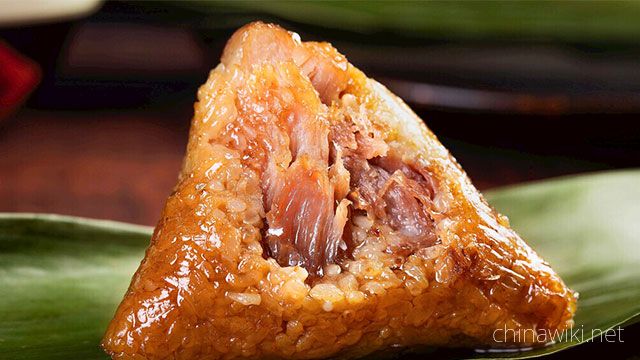History of Zongzi in China
Zongzi, also known as Zongzi, is mainly made of glutinous rice and stuffing, wrapped with Ruo leaves (or new leaves, ancient bougainvillea leaves, etc.), and has various shapes, mainly in angular and quadrangular shapes. Zongzi has a long history. It was originally used as a tribute to ancestors and gods. Zongzi, as one of the most profound traditional foods in Chinese history and culture, has spread far.
The word "Zongzi" was written in ancient times as "Zongzi". Historically, the written records of Zongzi were probably first seen in Shuowen Jiezi by Xu Shen of the Han Dynasty, which was interpreted as "reed leaves wrapped in rice". At the end of the Eastern Han Dynasty, millet was soaked in ash water from plants and trees. Due to the alkaline content in the water, millet was wrapped in bamboo leaves in a square shape and cooked, known as Guangdong alkaline water Zongzi. At the same time, a small amount of Zongzi stuffed with pork is the most popular.
Zongzi, a type of food, has been passed down for a long time. In the "Fengtu Ji" written by Zhou Chu, the prefect of Xinping in the Western Jin Dynasty, the term "Jiaoshu" was explicitly mentioned: "In the middle of summer, at the end of the fifth year, Fang Boxie was extremely satisfied. When enjoying Jiaoshu, the turtle scales were Shunde." In the north, millet was produced and used to make Zongzi in the shape of horns. In ancient times, it was called "Jiaoshu" in the north. According to research, Zongzi appeared before the Spring and Autumn period and was originally used to worship ancestors and gods; In the Jin Dynasty, Zongzi became the festival food of the Dragon Boat Festival.
In the Jin Dynasty, Zongzi was officially designated as the food of the Dragon Boat Festival. At this time, in addition to glutinous rice, the raw materials for wrapping Zongzi are also added with Chinese medicine Yizhiren. The cooked Zongzi is called "Yizhizong". Rice mixed with chestnuts and other ingredients leads to an increase in variety. Zongzi is also used as a gift for communication.
Tang Dynasty: Zongzi rice has been "white as jade", and the shape of Zongzi appears cone and diamond. The Japanese literature records "Zongzi of the Tang Dynasty".
During the Song Dynasty, there was already "preserved rice dumplings", which means that fruits were added to the rice dumplings. The poet Su Dongpo once said, "I see yangmei in the Zongzi.". At this time, there were advertisements made with Zongzi stacked into pavilions and wooden carts, indicating that eating Zongzi was very fashionable in the Song Dynasty.
During the Yuan and Ming Dynasties, the wrapping material of Zongzi has changed from wild rice leaves to indocalamus leaves. Later, Zongzi wrapped with reed leaves appeared. Additional materials have appeared such as bean paste, pine nut, jujube, walnut, etc. The variety of Zongzi is more colorful.
Ming and Qing Dynasties: Zongzi wrapped in reed leaves appeared, and bean paste, pine nut kernels, dates, walnuts, red beans and other additives appeared, making the variety more colorful. "Ham Zongzi" appeared in the Qing Dynasty. During the Ming and Qing dynasties, Zongzi became an auspicious food. According to legend, at that time, all the scholars who took the imperial examination, especially before the college entrance examination, had to eat the "brush Zongzi" specially wrapped for them at home before going to the examination room. It looked slender and looked like a brush, with a homophonic sound of "must hit", in order to win praise.
Until now, at the beginning of the fifth month of the lunar calendar every year, Chinese people have soaked glutinous rice, washed Zongzi leaves, and made Zongzi, with more varieties. From the filling, Beijing jujube Zongzi, which is often wrapped with small dates in the north, is often used; In the south, there are mung beans, streaky pork, bean paste, babao, ham, mushrooms, egg yolk and other fillings, with Guangdong salty meat dumplings and Zhejiang Jiaxing Zongzi as representatives. The Zongzi in various places are usually wrapped with ruo shells, but the color of the rice depends on the local specialties and customs. The custom of eating Zongzi has been popular in China for thousands of years, and has spread to Korea, Japan and Southeast Asian countries.
In September 2019, the proposal of "Zongzi International Standard" put forward by the China Chamber of Commerce passed the project approval review at the 21st Codex Alimentarius Commission Asia Regional Coordination Meeting (CCASIA21). This will help the Chinese traditional wrapped dumplings intangible heritage inheritance skills to go global, and better promote the Chinese flavor of Zongzi to the world.

History of Zongzi in China
-
Song Yanfei apologizes to Tong Dawei six years later for refusing to play pig Bajie, and is forgiven. Another teacher on the scene reacts with a heated discussion
Song Yanfei apologizes to Tong Dawei six years later for refusing to play pig Bajie, and is forgiven. Another teacher on the scene reacts with a heated discussion.
Views: 18 Time 2021-06-19 -
Chinese scientists make male mice pregnant, the process is very complicated
Pregnant mice model experiment constructed on male mice (source: biorxiv, life science preprint platform)
Views: 19 Time 2021-06-19 -
How powerful is the Chinese space station manipulator? This series of actions is so cool!
On June 21, according to media reports, the manipulator on the core module of China space station is the most intelligent, difficult and complex space intelligent manufacturing system in China. It is the most authentic restoration of human arm. The maximu
Views: 14 Time 2021-06-21 -
Yuan Longping: father of Hybrid Rice
Beijing News (reporter Yang Feifei) on June 24, the 2021 Beijing junior high school academic level examination officially began. This morning, the examination subject is Chinese.
Views: 18 Time 2021-06-24 -
Remember to give your brain a vacation! Doctors suggest that daze can prevent brain fatigue, can daze rest brain
You know what? There are many advantages of being in a daze. It can not only prevent brain fatigue and release pressure, but also improve the cognitive ability of the brain and stimulate your creativity.
Views: 16 Time 2021-06-25 -
Here comes the magnificent picture! Chinese space station astronaut's first EVA
The first extravehicular activity of astronauts will install an extension bracket, which will greatly improve the field of vision of panoramic camera a and bring you more space beauty
Views: 21 Time 2021-07-04 -
The elephant group forms a circle to warm the elephant
On the morning of July 5, the elephants changed their territory, left Eshan County, Yuxi City, Yunnan Province, where they stayed for 18 days, and entered Xinping County.
Views: 17 Time 2021-07-06 -
PLA military aircraft entered Taiwan's southwest airspace yesterday evening
The island's green media freedom times claimed that the "Communist aircraft" had intensively "harassed" Taiwan's adjacent airspace in recent years, and entered Taiwan's southwest airspace in the evening of the 15th.
Views: 25 Time 2021-08-16 -
Jay Chou also entered the game. What is the risk of 10000 NFTs being sold short in 40 minutes?
2021 is called the first year of "NFT" by many people. The development of NFT is an important breakthrough in the field of global blockchain this year. Nowadays, in addition to major enterprises, many star singers have joined the Bureau, and all
Views: 21 Time 2022-01-02 -
History of Zongzi in China
Zongzi, also known as Zongzi, is mainly made of glutinous rice and stuffing, wrapped with Ruo leaves (or new leaves, ancient bougainvillea leaves, etc.), and has various shapes, mainly in angular and quadrangular shapes. Zongzi has a long history. It was
Views: 778 Time 2024-05-01 -
Historical Records of Zongzi
Historical records about Zongzi can be found in Shuowen Jiezi by Xu Shen of the Han Dynasty. The character "zongzi" is originally called "gao", with reed leaves wrapped in rice. From the meter, the sound of sound.
Views: 651 Time 2024-05-06 -
China empowers grain production through technological innovation
According to a report on the website of Singapore's Lianhe Zaobao on December 19, China will vigorously promote the increase of grain per unit area yield in a large area next year, consolidate the results of soybean oil seed expansion, and spare no effort
Views: 7 Time 2024-12-21


